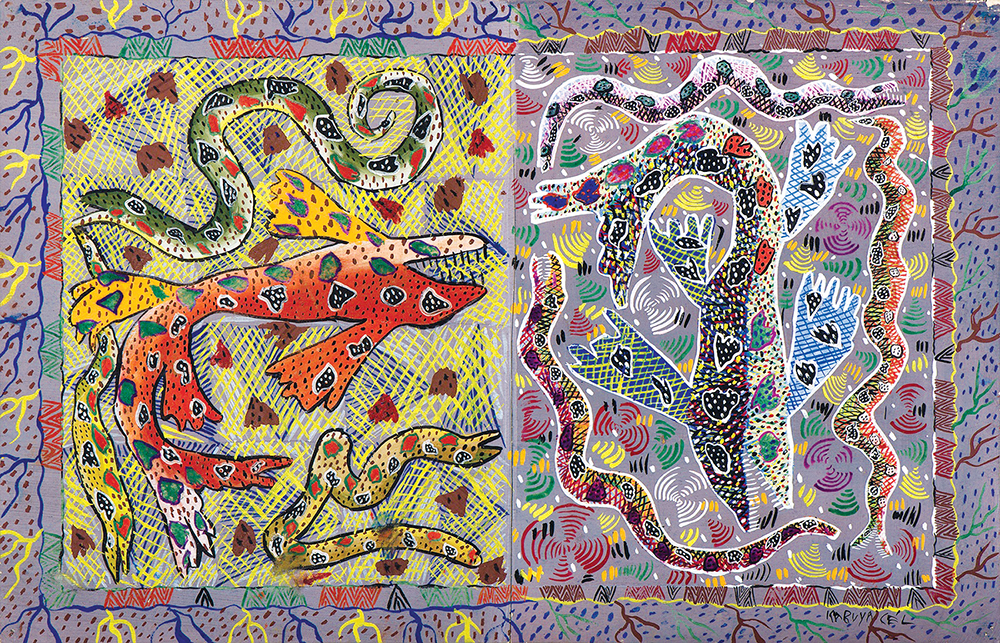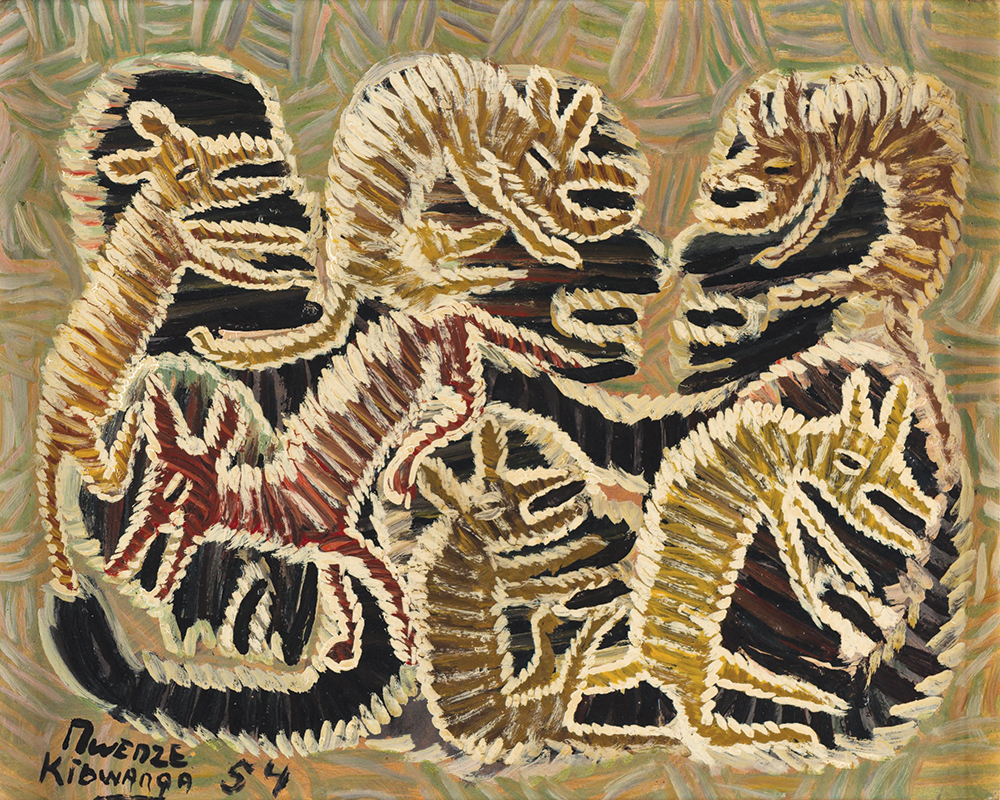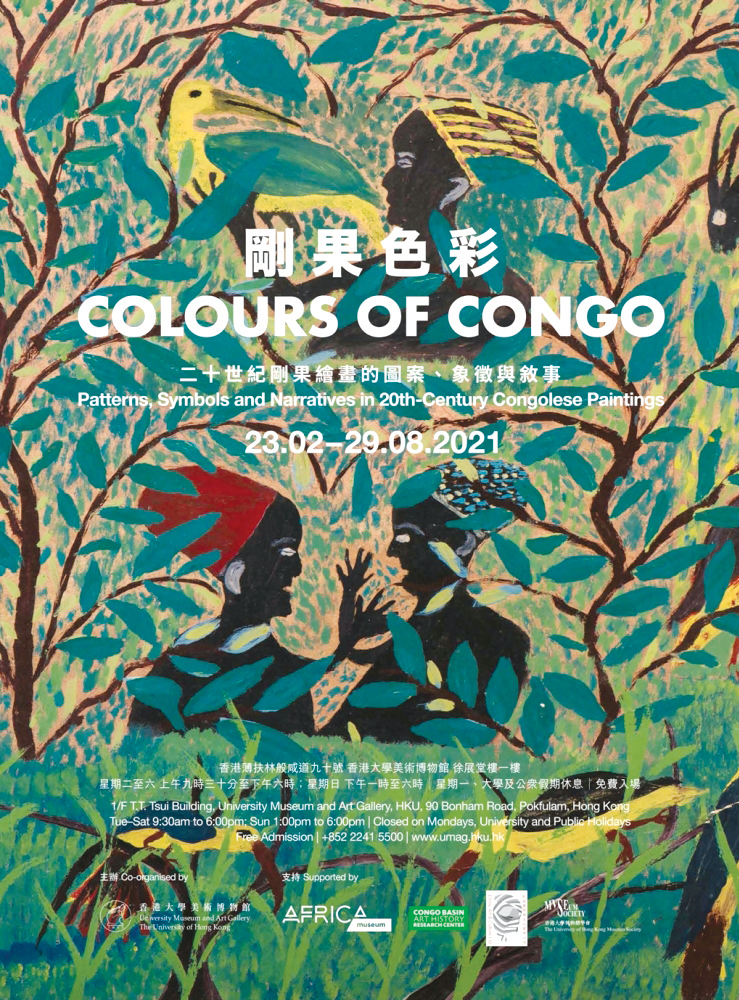May 2021 | Volume 22 No. 2
True Colours
Untitled (Lakebed)
Oil on panel, 61.5 x 83 cm
Signed ‘BELA’
ca. 1960
Pierre Loos Collection
(Image courtesy of Michael De Plaen)
The unique artistic collaboration began with Georges Thiry, a man who worked for Belgium’s colonial offices in Elisabethville (now Lubumbashi) in the Congo in 1926. His curiosity was piqued when he saw wall murals of crocodiles and birds in the town and arranged to meet the artist behind them, Albert Lubaki. Thiry launched a series of workshops with Lubaki and other local artists in the community, and out of these workshops a hybrid art form was developed that would later become a celebrated phenomenon.
UMAG Director Dr Florian Knothe came up with the idea of displaying a selection of Congolese works created from the 1920s through to 1960 in an exhibition called Colours of Congo: Patterns, Symbols and Narratives in 20th-Century Congolese Paintings, and of making its development a collaborative project. The collective effort saw Dr Knothe working with a team from the African Studies Programme at HKU integrated by Dr Estela Ibáñez-García, Temporary Assistant Professor, Mr Clifford Pereira, Visiting Research Associate, and a group of undergraduate students, as well as with Congo specialist Dr Thomas Bayet and private collectors based in Brussels.
Personal connections allowed for unprecedented access to extensive archives and art collections – such as the Dierickx, Loos and Moonens Archives and the Royal Museum for Central Africa in Tervuren, Brussels – and enabled this diverse team of curators to develop the exhibition into a wide-ranging overview of the art and artists, giving viewers a taste of what fascinated Thiry about an artistic community whose work articulates what life was like under colonial rule through scenes that chronicle changing realities.
“The exhibition and accompanying volume of essays examine this group of paintings as artworks worth considering on their own merits, describing the techniques used and their inherent beauty and highlighting how their iconographic contents reflect daily life within the Congolese village communities,” said Dr Knothe. “Both the curators and the students studied different aspects of the cross-cultural and inter-dependent culture of the late colonial years and added their voices to an unprecedented, descriptive as well as critical discussion of the exhibited Congolese artistic achievements.”
Added Dr Ibáñez-García: “A close reading of these paintings reveals how Congolese artists articulated and represented their own experiences during colonial times. A critical reading of how the Europeans used and interpreted those creations is also revealing of their own worldview. This in-flux dimension of the world as it changes with the position and stance of the individual is at the core of what humanities are about.”
For the students involved in developing the exhibition, the course brought research and teaching into close dialogue, fostered active learning and critical thinking, and let the students co-construct knowledge by themselves.

Célestin Kabuya
Untitled (Lakebed)
Gouache on paper, 40 x 61 cm
Signed ‘Kabuya Cel.’
ca. 1956
Pierre Loos Collection
(Image courtesy of Michael De Plaen)

Mwenze Kibwanga
Untitled (Metamorphoses)
Oil on panel, 39 x 48 cm
Signed ‘MWENZE KIBWANGA 54’
1954
Pierre Loos Collection
(Image courtesy of Michael De Plaen)
Curatorial strategies
“Our undergraduate students started by examining the type of knowledge that is produced through curatorial strategies,” said Dr Ibáñez-García. “They focussed on the relevant role that exhibitions played in the understanding of African arts and African history during the 20th century, as well as how those exhibitions in turn contributed to a reconsideration of the issues and core concepts in Western art history in the recent past. After this critical and theoretical analysis, the students adopted the role of researchers and curators thus experiencing first-hand the complexity and relevance of curatorial work through the collaboration with UMAG.”
Dr Knothe’s contribution included showing them what goes on ‘behind the scenes’ of the museum world, revealing the intricacies of curatorial work, and sharing with the students a selection of images of the paintings that would be displayed in the exhibition.
“A core dimension of this learning experience was to help the students reflect upon the implications of representations of the Congo through its art,” said Dr Ibáñez-García. “What they discovered along the way was that both exhibitions and artworks are meaningful constructs that shape reality. Through a close reading of the paintings from a contextual and interdisciplinary perspective, the students discovered that art can give voice to those who were muted for a long time if approached from their own perspective.”
Dr Knothe concluded: “Our exhibition and the accompanying book discuss a little-known phenomenon. The historical and sometimes religious, as well as the varied contemporary and ‘lived’ experience inspired the paintings we discuss. However, their impact on the African continent and abroad is immeasurable and as diverse as the sources they are based upon.”

Colours of Congo: Patterns, Symbols and Narratives in 20th-Century Congolese Paintings
Date: From now till August 29, 2021
Venue: 1/F, TT Tsui Building, University Museum and Art Gallery
Visit the virtual exhibition here.
A close reading of these paintings reveals how Congolese artists articulated and represented their own experiences during colonial times. A critical reading of how the Europeans used and interpreted those creations is also revealing of their own worldview. This in-flux dimension of the world as it changes with the position and stance of the individual is at the core of what humanities are about.

DR ESTELA IBÁÑEZGARCÍA

